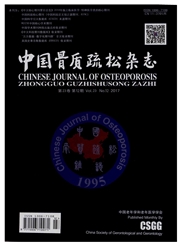

 中文摘要:
中文摘要:
目的分析老年股骨粗隆间骨折患者行PFNAII内固定术后髋关节骨密度的变化情况,为防止术后内固定失败和再发骨折提供理论依据。方法对40例符合条件的老年股骨粗隆间骨折患者在术后1天应用双能X线吸光测定法(DXA)分别测定其健侧和患侧髋关节骨密度,嘱患者术后6周开始在助步器辅助下功能锻炼并坚持服用钙剂和维生素D3。对术后3个月按时到诊随访的患者再次测量双侧髋关节骨密度,应用SPSS18.0统计软件对数据进行统计学分析。结果术后3个月较术后1天的患侧髋关节分区BMD除了粗隆间内区(R3)、粗隆间外区(R4)和全患侧髋关节区(RG)无显著性差异外,其余各区(R1、R2、R5、R6、R7、R8、R9)均有显著性下降,其下降幅度分别为6.982%、4.447%、10.483%、11.810%、8.624%、8.017%和8.342%,下降速度的顺序依次为R6〉R5〉R7〉R8〉R9〉R1〉R2。健侧髋关节除Ward’s三角区(Ward’s)的BMD值有显著升高外,股骨颈区(Neck)、股骨大粗隆区(Troch)、股骨粗隆间区(Inter)和健侧全髋部区(Total)的BMD值均无显著性改变。结论 PFNAII术后可能由于应力遮挡造成了髓内钉周围骨量丢失,积极地预防和治疗骨质疏松症并根据患者个体情况指导其在术后尽可能早地开始功能锻炼对减少内固定失败和预防再骨折发生具有重要意义。
 英文摘要:
英文摘要:
Objective To investigate the changes of the bone mineral density (BMD) of the hip in the aged patients with intertrochanteric fractures after PFNAII internal fixation, and to provide theoretical basis for preventing the failure of internal fixation and recurrent fractures. Methods Forty elder patients with intertrochanteric fractures were enrolled in this study. BMD of the healthy and the fractured hip was detected using dual-energy X-ray absorbfiometry (DXA) at the 1 st day after the operation. All the patients were required to begin functional exercise at the 6th week after the operation and to take oral medication of calcium and vitamin D3. At the 3rd month after the operation, BMD of the bilateral hip in the patients who had completed 3-month follow-up was detected again. All the data were statistically analyzed using a SPSS 18.0 software. Results At the 3rd month after the operation, except for the interior- intertrochanteric (R3), the lateral-intertrochanteric (R4), and the global fracture hip (RG) region, BMD of the left parts of the fractured hip ( R1, R2, R5, R6, R7, R8, and R9) decreased statistically significant compared with that at the 1st day after the operation. And the descending range was 6. 982% , 4.447% , 10. 483% , 11. 810% , 8. 624% , 8. 017% , and 8. 342% , respectively. And the descending speed was listed as R6 〉 R5 〉 R7 〉 R8 〉 R9 〉 R1 〉 R2. Except for BMD of the Ward' s triangle region, BMD of the healthy hip, including the Neck, the Troch, the Inter, and the Total region, showed no statistically significant difference. Conclusion Stress-shielding after the PFNAII internal fixation may contribute to the loss of bone mass around the intramedullary nails. Preventing and treating osteoporosis actively and instructing patients to begin functional exercise as early as possible have important significance to prevent the failure of internal fixation and the recurrent fractures.
 同期刊论文项目
同期刊论文项目
 同项目期刊论文
同项目期刊论文
 期刊信息
期刊信息
